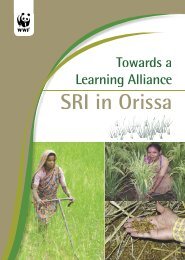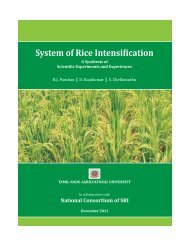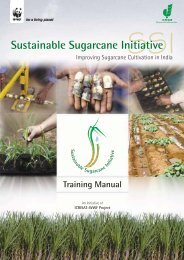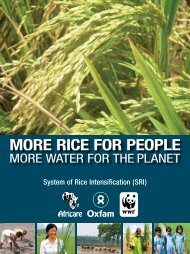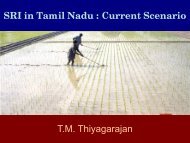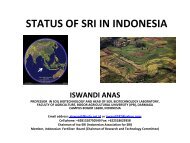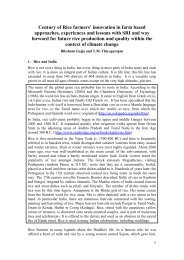SSI Newsletter - SRI - India
SSI Newsletter - SRI - India
SSI Newsletter - SRI - India
Create successful ePaper yourself
Turn your PDF publications into a flip-book with our unique Google optimized e-Paper software.
During the <strong>SSI</strong> Training Manual Release: From (Lto R) Dr. S. P. Wani, Principal Scientist, ICRISAT; Shri. Prabhakar Reddy, President,<br />
Farmers Federation of AP; Dr. Biksham Gujja, Team Leader, ICRISAT-WWF Project, Dr. William Dar, Director General, ICRISAT;<br />
Shri. Sucha Singh,Hon’ble Agriculture Minister, Punjab; Dr. Dave Hoisington, Deputy Director General-Research, ICRISAT;<br />
Dr. Vithal Rajan, Board of Directors, KCP Sugars; Shri. P. K. Singh, General Manager-Cane, Triveni Engineering & Industries Ltd<br />
producing states in <strong>India</strong> - in AP, where<br />
132 lakh MT of cane was crushed in<br />
2007-08 and that figure came down<br />
by more than half, to 60 lakh MT in<br />
2008-09; in UP, the average number of<br />
millable canes per unit area has come<br />
down by as much as 40% which means<br />
the average yield has been only 40 to 60<br />
t/ha, though this state has the largest<br />
area under cultivation of sugarcane.<br />
Sugarcane production is expected<br />
to reduce by 30% in the future due<br />
250<br />
200<br />
150<br />
100<br />
50<br />
0<br />
Andhra Pradesh<br />
Assam<br />
Bihar<br />
Gujarat<br />
Haryana<br />
Karnataka<br />
Madhya Pradesh<br />
to climatic change, as revealed in a<br />
recent four-year study conducted by<br />
the World Bank.<br />
While sugar mills are suffering due<br />
to inadequate supply of cane for<br />
crushing, the sugarcane farmers are<br />
facing problems of their own. On<br />
the one hand, the cost of cultivating<br />
cane is increasing and on the other,<br />
the prices offered by the factories are<br />
making it uneconomical to continue<br />
its cultivation. Therefore, farmers have<br />
State-wise Area, Production and Productivity of Sugarcane<br />
in <strong>India</strong> (2006-07)<br />
Maharashtra<br />
Orissa<br />
Punjab<br />
Tamil Nadu<br />
Uttar Pradesh<br />
Area (‘0000 ha) Production (MT) Productivity (t/ha)<br />
Uttarakhand<br />
West Bengal<br />
Source: Directorate of Economics and Statistics, Ministry of Agriculture<br />
no choice but to shift to remunerative<br />
commercial crops.<br />
Under these circumstances, if <strong>India</strong> has<br />
to sustain its sugarcane production<br />
profitably, it needs to improve the<br />
productivity of sugarcane per unit of<br />
land, water, labour and capital all at<br />
the same time, while striking a balance<br />
between economy and ecology.<br />
Responding to this need, World<br />
Wide Fund for Nature (WWF) has<br />
partnered with International Crops<br />
Research Institute for the Semi-Arid<br />
Tropics (ICRISAT) to explore options<br />
for “Improving water productivity in<br />
Agriculture” in order to improve water<br />
use efficiency and reduce pressure on<br />
freshwater ecosystems.<br />
Based on the principles of ‘more with<br />
less’ in agriculture, the project initiated<br />
its work on the first crop, rice – as it is the<br />
largest water-guzzling crop - through<br />
field extension, documentation, and<br />
research and policy advocacy to<br />
popularise and mainstream the System<br />
of Rice Intensification (<strong>SRI</strong>) method in<br />
rice cultivation (see website: www.sriindia.net).<br />
Encouraged by the results in<br />
the fields and success of the project in<br />
promoting <strong>SRI</strong> for more than 5 years<br />
now, the focus shifted to sugarcane in<br />
the last one and half years.<br />
Nov ‘09<br />
5<br />
SugarCane<br />
matters





